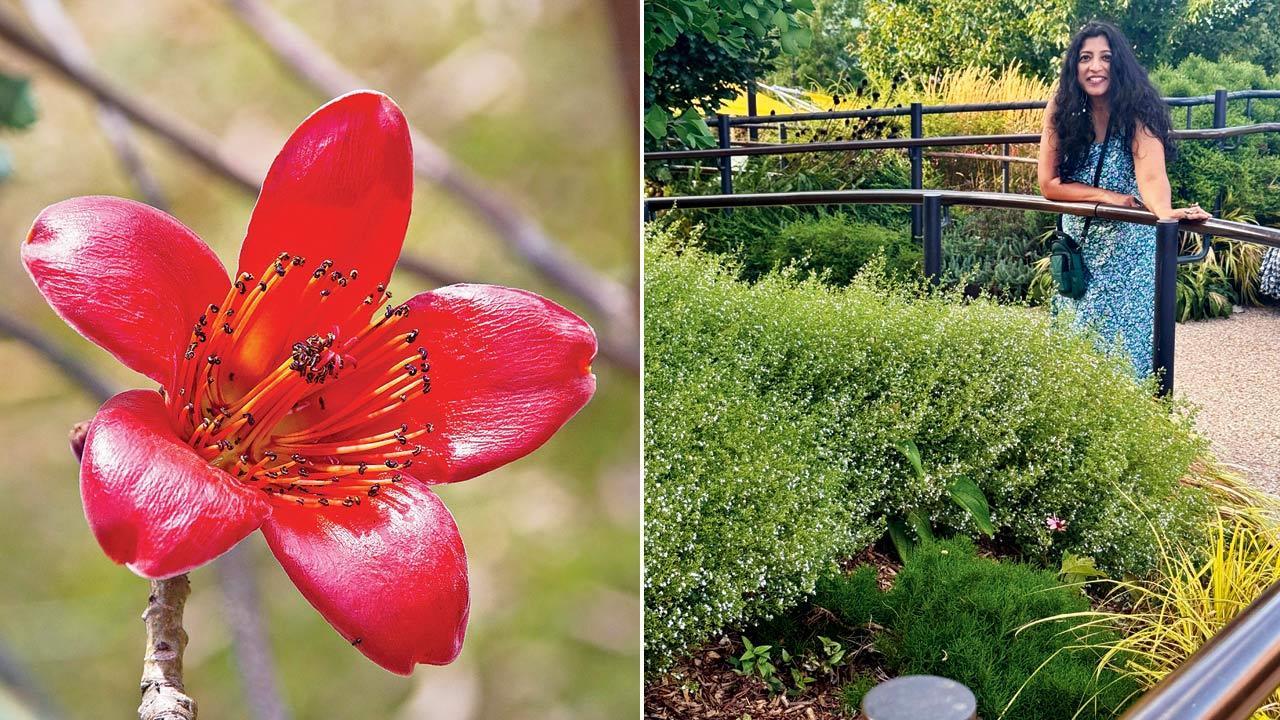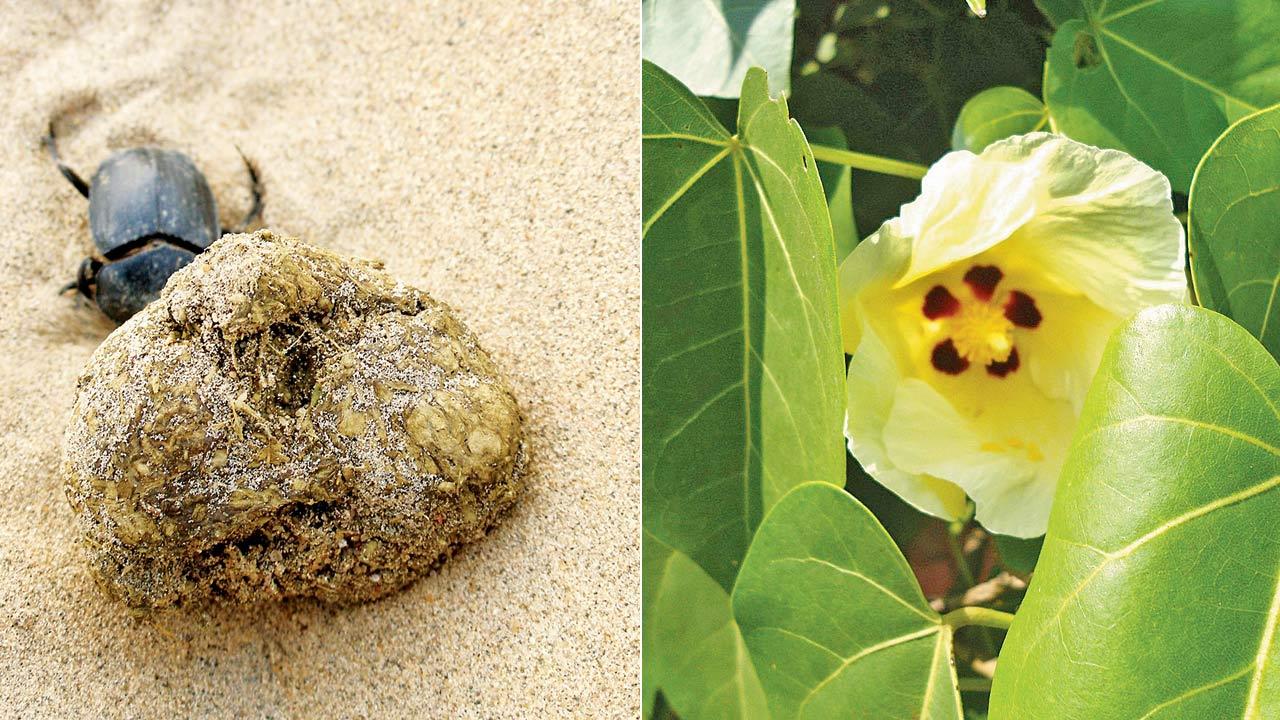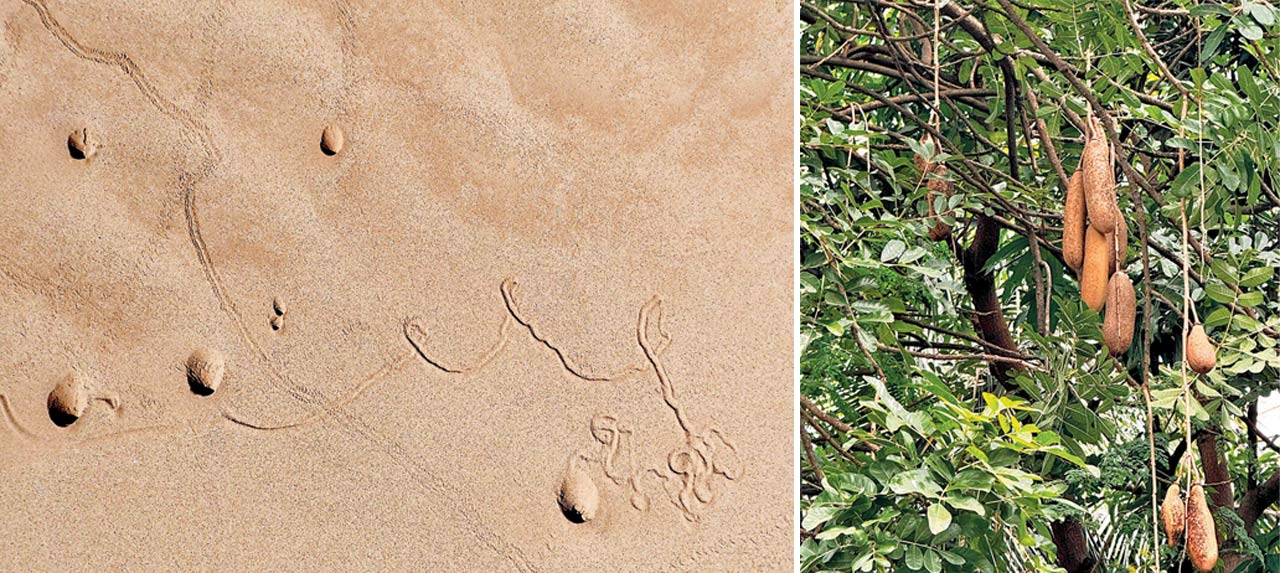A hortitect’s pictorial guide reveals ways to transform hidden backyard flora into a vibrant urban haven

Katesavar (Red Silk Cotton Trees) flowers; (right) Dr Aseem Gokarn Harwansh’s book, Secrets of Your Urban Backyard, is a hortitect’s ode to Mumbai and its environment
![]() The 400-year-old landmark Mumbadevi Temple, located in the bustling Bhuleshwar area, often makes headlines for events like the mango festival. The trustees of the shrine to the city’s patron deity are featured in newspapers for their appeals against devotees wearing torn jeans during Navratri visits. But rarely is the temple recalled in the context of the 24-odd tree species—Vilayati Chinch, Gulmohur, Karanj, Peepal—that form a beautiful green oasis in the heart of the city.
The 400-year-old landmark Mumbadevi Temple, located in the bustling Bhuleshwar area, often makes headlines for events like the mango festival. The trustees of the shrine to the city’s patron deity are featured in newspapers for their appeals against devotees wearing torn jeans during Navratri visits. But rarely is the temple recalled in the context of the 24-odd tree species—Vilayati Chinch, Gulmohur, Karanj, Peepal—that form a beautiful green oasis in the heart of the city.
Dr Aseem Gokarn Harwansh’s newly-launched book, Secrets of Your Urban Backyard, reaffirms the importance of many iconic Mumbai landmarks, like Mumbadevi, by highlighting the flora and fauna they nurture. Whether it’s the beach almonds at Versova, the fishtail palm along the Mumbai-Pune Expressway, the cannonball tree at Bombay High Court, or the Tailed Jay subtropical butterfly at Borivli’s LIC Colony, Dr Harwansh urges readers to appreciate the green havens that still exist, even in their limited shrunk forms. At a time when Mumbai’s congestion (among the 10 most traffic-dense cities of the world) is being discoursed with reference to the new crop of gated “redeveloped” high rise complexes, the book reminds the reader of whatever little precious green surroundings that can be valued.
Also, in the light of the “wrong”, misdirected tree plantation drives in Mumbai, focusing on ornamental foreign species, Dr Harwansh’s pictionary awakens the reader to the ecological heritage of Mumbai and its getaways. Dr Harwansh is currently involved in an integrated community development and beautification design of the Mumba Devi precinct which preserves the tree heritage, minimising grading and site disturbance.
 Dung-roller; (right) Bhendy (thespesia populnea)
Dung-roller; (right) Bhendy (thespesia populnea)
The reimagined Mumbadevi Talao (a kund, with lotus ponds and misting fountains) will cool the area and purify the air. The proposed Nakshatra and Nirvana trails, lined with trees and shrubs, will have a meditative vibe.
Dr Harwansh is working with the municipal corporation to ensure similar integration at Mahim and Worli Koliwada sites; a marine education centre is envisaged in the Koliwadas, along with sea food plazas.
She is a passionate voice against the Gliricidia sepum (quickstick tree) which prevents and impedes growth of native species. She also warns against Subabhul which was introduced in India as firewood, but it is hollow, germinates easily, seeds profusely and is super-difficult to eradicate. Similarly, Conocarpus grows very fast and withdraws ground water very rapidly.
 Ant lion; (right) Kigelia pinnata
Ant lion; (right) Kigelia pinnata
“I choose to celebrate the native tapestry, though I do lament the trees cut in the name of redevelopment,” says Dr Harwansh, who has written extensively on the city’s biodiversity. Her upcoming handbook of plant care contains tips and tricks to create a better greenscape in a house balcony, alley, terrace, office foyer or kitchen window.
The author’s 26 years as an urban landscape and a nature-based solutions expert runs parallel to her involvement in various global fora for protection of trees. She is associated with International Tree Performance Initiative, based out of Trinidad and Tobago, which carries out tree research across the globe. She represented India at the 100th edition of the International Society of Arboriculture where she spoke on trees and climate action. She worked twice as an expert on the State Environment Action Committee. She collaborated with schools to create ecologically sustainable campuses with barefoot play zones and butterfly parks. She co-authored a textbook that was part of the syllabus in the agriculture-horticulture universities in 2004.
The secrets of 65-odd varieties shared by Dr Harwansh in her new book are lesser known or forgotten facts. Some of the notations border on the obvious, such as the trimming needed for the non-fussy, fast-growing money plant (associated with good fortune vibes) which removes indoor pollutants. Also simple are the directions to feed and protect the house sparrow, which currently is on the International Union for Conservation of Nature’s red list of endangered species. Similarly, mandatory is the caution against feeding pigeons—carriers of multiple respiratory ailments—and the common Indian mynah, which are among the world’s invasive species.
But the book does a good job of repeating essential concepts, reinforcing ideas that, though familiar, inspire change when consistently shared. This approach encourages readers to take small steps, which are often the foundation for a larger shift in understanding and action.
The book also houses some a-ha discoveries of plant and animal species—awakening us to the love grass (eragrostis unioloides), milkweeds (calotropis) and sickle pod (senna tora) growing abundantly along highways and wastelands. We are made aware of the Red Silk Cotton Trees (also known as katesavar) with dark pink flowers, which are seen in Mumbai and Delhi too. How often do we stop to wonder over the mangrove-saviour Bhendy (thespesia populnea) tree? Do we notice the huge cylindrical sausages (kigelia africana/pinnata) hanging from tree avenues in Thane and Vashi? Is our curiosity piqued by the antlions—nature’s doodle artists—which lay pit traps on the sandy soil? Equally interesting are the dung-rolling glossy beetles (scarabaeus viettei) seen near cattle sheds, which do their bit to increase the nutrient quality of the soil.
Secrets of Your Urban Backyard is a hortitect’s (combining horticulture and architect) ode to Mumbai and its environment. Born in Tardeo and educated in Pune and Nashik, Dr Harwansh was drawn to the greenery of her family farm in Wada as a child. It sparked her interest in horticulture, leading her all the way to a postgraduate degree. Her doctoral thesis revolved around promoting and managing urban vegetation in Mumbai, to create an eco-friendly environment. Her new book of “secrets” serves as a natural extension of her childhood vision.
Sumedha Raikar-Mhatre is a culture columnist in search of the sub-text. You can reach her at sumedha.raikar@mid-day.com
 Subscribe today by clicking the link and stay updated with the latest news!" Click here!
Subscribe today by clicking the link and stay updated with the latest news!" Click here!










